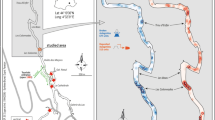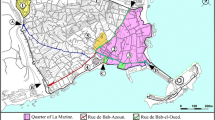Abstract
We analyzed bare human footprints in Holocene tuff preserved in two pits in the Acahualinca barrio in the northern outskirts of Managua (Nicaragua). Lithology, volcanology, and age of the deposits are discussed in a companion paper (Schmincke et al. Bull Volcanol doi: 10.1007/s00445-008-0235-9, 2008). The footprint layer occurs within a series of rapidly accumulated basaltic–andesitic tephra that is regionally correlated to the Masaya Triple Layer Tephra. The people were probably trying to escape from a powerful volcanic eruption at Masaya Caldera 20 km farther south that occurred at 2.1 ka BP. We subdivided the swath of footprints, up to 5.6 m wide, in the northern pit (Pit I) into (1) a central group of footprints made by about six individuals, the total number being difficult to determine because people walked in each other’s footsteps one behind the other and (2) two marginal groups on either side of the central group with more widely spaced tracks. The western band comprises tracks of three adjacent individuals and an isolated single footprint farther out. The eastern marginal area comprises an inner band of deep footprints made by three individuals and, farther out, three clearly separated individuals. We estimate the total number of people as 15–16. In the southern narrow and smaller pit (Pit II), we recognize tracks of ca. 12 individuals, no doubt made by the same group. The group represented in both pits probably comprised male and female adults, teenagers and children based on differences in length of footprints and of strides and depth of footprints made in the soft wet ash. The smallest footprints (probably made by children) occur in the central group, where protection was most effective. The footprint layer is composed of a lower 5–15-cm thick, coarse-grained vesicle tuff capped by a medium to fine-grained tuff up to 3 cm thick. The surface on which the people walked was muddy, and the soft ash was squeezed up on the sides of the foot imprints and between toes. Especially, deep footprints are mainly due to local thickening of the water-rich ash, multiple track use, and differences in weight of individuals. The excellent preservation of the footprints, ubiquitous mudcracks, sharp and well-preserved squeeze-ups along the margins of the tracks and toe imprints, and the absence of raindrop impressions all suggest that the eruption occurred during the dry season. The people walked at a brisk pace, as judged from the tight orientation of the swath and the length of the strides. The directions of a major erosional channel in the overlying deposits that probably debouched into Lake Managua and the band of footprints are strictly parallel, indicating that people walked together in stride along the eastern margin of a channel straight toward the lake shore, possibly a site with huts and/or boats for protection and/or escape.













Similar content being viewed by others
References
Anonymous. Leaflet for visitors. Acahualinca Museum, Managua
Brinton DG (1887) On an ancient human footprint from Nicaragua. Am Philos Soc Proc 24:437–444
Bryan AL (1973) New light on ancient Nicaraguan footprints. Archaeol 26:146–147
Crawford J (1891) Neolithic man in Nicaragua. Am Geol 8:160–166
Flint E (1884) Human footprints in Nicaragua. Am Antiquarian Orient J 6:112–114 (1885) idem 7:156–158
Freundt A, Kutterolf S, Schmincke H-U, Hansteen TH, Wehrmann H, Pérez W, Strauch W, Navarro M (2006) Volcanic hazards in Nicaragua: past, present and future. In: Rose WI, Bluth GJS, Carr MJ, Ewert J, Patino LC, Vallance JW (eds) Volcanic hazards in Central America. Geological Society of America special publication, pp 141–165
Giles E, Vallandigham PH (1991) Height estimation from foot and shoeprint length. J Forensic Sci 36:1134–1151
Hay RL (1978) Melilitite-carbonatite tuffs in the Laetoli Beds of Tanzania. Contrib Mineral Petrol 67:357–367. doi:10.1007/BF00383296
Hay RL, Leakey MD (1982) The fossil footprints of Laetoli. Sci Am 246:38–45
Jaggar TA (1921) Fossil human footprints in Kau Desert. Hawaii Volcano Observ Month Bull 9:114–118
Kutterolf S, Freundt A, Pérez W, Wehrmann H, Schmincke H-U (2007) Late Pleistocene to Holocene temporal succession and magnitudes of highly explosive volcanic eruptions in west-central Nicaragua. J Volcanol Geotherm Res 163:55–82. doi:10.1016/j.jvolgeores.2007.02.006
Kutterolf S, Freundt A, Peréz W, Mörz T, Schacht U, Wehrmann H, Schmincke H-U (2008) The Pacific offshore record of Plinian arc volcanism in Central America, part 1: along-arc correlations. Geochem Geophys Geosyst 9. doi:10.1029/2007GC001631
Lange FW (1997) The Managua Metropolitan area archeological project. ICOMOS Committee Newsletter 1
Leakey MD, Hay RL (1979) Pliocene footprints in the Laetoli Beds at Laetoli, northern Tanzania. Nature 278:317–323. doi:10.1038/278317a0
Meldrum DJ (2004) Fossilized Hawaiian footprints compared with Laetoli hominid footprints. In: Meldrum DJ, Hilton CE (eds) From biped to strider. The emergence of modern human walking, running and resource transport. Kluwer Academic/Plenum Publishers, New York, pp 63–83
Mietto P, Avanzini M, Rolandi G (2003) Human footprints in Pleistocene volcanic ash. Nature 422:133. doi:10.1038/422133a
Moniz-Nakamura JJ (2009) Hominid footprints in recent volcanic ash: new interpretations from Hawaii Volcanoes National Park. Hawaii Volcanoes National Park. Resour Manage Div (in press)
Pérez W, Freundt A (2006) The youngest highly explosive basaltic eruptions from Masaya Caldera (Nicaragua): stratigraphy and hazard assessment. In: Rose WI, Bluth GJS, Carr MJ, Ewert J, Patino LC, Vallance JW (eds.) Volcanic hazards in Central America. Geological Society of America special publication, pp 189–207
Richardson FB (1941) Report on Nicaragua. Carnegie Inst Wash Yearb 40:300–302
Richardson FB, Ruppert K (1942) Nicaragua. Carnegie Inst Wash Yearb 41:269–271
Schmincke H-U, Freundt A, Kutterolf S, Perez W (2005) Acahualinca. Terra Nostra, 19th Colloquium on Latin American Geosciences, Potsdam vol 2005/1
Schmincke H-U, Rausch J, Kutterolf S, Freundt A (2007) Acahualinca revisited. Abstract. In: LAK 2007, pp 210–211. http://www.lak2007.uni-kiel.de/
Schmincke H-U, Kutterolf S, Perez W, Rausch J, Freundt A, Strauch W (2008) Walking through volcanic mud: the 2,100 year-old Acahualinca footprints (Nicaragua). I Stratigraphy, lithology, volcanology and age of the Acahualinca section. Bull Volcanol. doi: 10.1007/s00445-008-0235-9
Swanson DA (2008) Hawaiian oral tradition describes 400 years of volcanic activity at Kilauea. J Volcanol Geotherm Res 176:427–431. doi:10.1016/j.jvolgeores.2008.01.033
Swanson DA, Christiansen RL (1973) Tragic base surge in 1790 at Kilauea Volcano. Geology 1(2):83–86. doi:10.1130/0091-7613(1973)1<83:TBSIAK>2.0.CO;2
Swanson DA, Rausch J (2008) Human footprints in relation to the 1790 eruption of Kilauea. Eos Trans AGU 89(53), Fall Meet Suppl, Abstract
Williams H (1952) Geologic observations on the ancient human footprints near Managua, Nicaragua. Carnegie Inst Wash Publ (Contrib Am Anthro Hist 11) 596:1–32
Acknowledgments
Our work is supported by grants from the Deutsche Forschungsgemeinschaft SFB 574. This is publication no. 142 of the Sonderforschungsbereich 574 “Volatiles and Fluids in Subduction Zones” at Kiel University. We thank Don Swanson, Gerhard Wörner and an anonymous reviewer for critical comments on the manuscript. Dr. Edgar Espinoza (Palacio Nacional de la Cultura (Managua, Nicaragua)) kindly granted permission to take samples in the Acahualinca pits.
Author information
Authors and Affiliations
Corresponding author
Rights and permissions
About this article
Cite this article
Schmincke, HU., Rausch, J., Kutterolf, S. et al. Walking through volcanic mud: the 2,100 year-old Acahualinca footprints (Nicaragua) II: the Acahualinca people, environmental conditions and motivation. Int J Earth Sci (Geol Rundsch) 99 (Suppl 1), 279–292 (2010). https://doi.org/10.1007/s00531-009-0438-0
Received:
Accepted:
Published:
Issue Date:
DOI: https://doi.org/10.1007/s00531-009-0438-0




